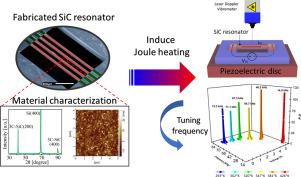当前位置:
X-MOL 学术
›
Mater. Des.
›
论文详情
Our official English website, www.x-mol.net, welcomes your
feedback! (Note: you will need to create a separate account there.)
Highly-doped SiC resonator with ultra-large tuning frequency range by Joule heating effect
Materials & Design ( IF 7.6 ) Pub Date : 2020-09-01 , DOI: 10.1016/j.matdes.2020.108922 Pablo Guzman , Toan Dinh , Hoang-Phuong Phan , Abbin Perunnilathil Joy , Afzaal Qamar , Behraad Bahreyni , Yong Zhu , Mina Rais-Zadeh , Huaizhong Li , Nam-Trung Nguyen , Dzung Viet Dao
Materials & Design ( IF 7.6 ) Pub Date : 2020-09-01 , DOI: 10.1016/j.matdes.2020.108922 Pablo Guzman , Toan Dinh , Hoang-Phuong Phan , Abbin Perunnilathil Joy , Afzaal Qamar , Behraad Bahreyni , Yong Zhu , Mina Rais-Zadeh , Huaizhong Li , Nam-Trung Nguyen , Dzung Viet Dao

|
Tuning the natural frequency of a resonator is an innovative approach for the implementation of mechanical resonators in a broad range of fields such as timing applications, filters or sensors. The conventional electrothermal technique is not favorable towards large tuning range because of its reliance on metallic heating elements. The use of metallic heaters could limit the tuning capability due to the mismatch in thermal expansion coefficients of materials forming the resonator. To solve this drawback, herein, the design, fabrication, and testing of a highly-doped SiC bridge resonator that excludes the use of metallic material as a heating element has been proposed. Instead, free-standing SiC structure functions as the mechanical resonant component as well as the heating element. Through the use of the Joule heating effect, a frequency tuning capability of almost ∆f/fo ≈ 80% has been demonstrated. The proposed device also exhibited a wide operating frequency range from 72.3 kHz to 14.5 kHz. Our SiC device enables the development of highly sensitive resonant-based sensors, especially in harsh environments.
中文翻译:

通过焦耳热效应实现超大调谐频率范围的高掺杂碳化硅谐振器
调谐谐振器的固有频率是一种创新方法,可用于在时序应用、滤波器或传感器等广泛领域中实现机械谐振器。传统的电热技术依赖于金属加热元件,不利于大调谐范围。由于形成谐振器的材料的热膨胀系数不匹配,使用金属加热器可能会限制调谐能力。为了解决这个缺点,本文提出了高掺杂 SiC 桥谐振器的设计、制造和测试,该谐振器不使用金属材料作为加热元件。取而代之的是,独立式 SiC 结构用作机械谐振组件以及加热元件。通过使用焦耳热效应,已经证明了几乎 ∆f/fo ≈ 80% 的频率调谐能力。所提出的设备还表现出从 72.3 kHz 到 14.5 kHz 的宽工作频率范围。我们的 SiC 器件能够开发高灵敏度的基于谐振的传感器,尤其是在恶劣环境中。
更新日期:2020-09-01
中文翻译:

通过焦耳热效应实现超大调谐频率范围的高掺杂碳化硅谐振器
调谐谐振器的固有频率是一种创新方法,可用于在时序应用、滤波器或传感器等广泛领域中实现机械谐振器。传统的电热技术依赖于金属加热元件,不利于大调谐范围。由于形成谐振器的材料的热膨胀系数不匹配,使用金属加热器可能会限制调谐能力。为了解决这个缺点,本文提出了高掺杂 SiC 桥谐振器的设计、制造和测试,该谐振器不使用金属材料作为加热元件。取而代之的是,独立式 SiC 结构用作机械谐振组件以及加热元件。通过使用焦耳热效应,已经证明了几乎 ∆f/fo ≈ 80% 的频率调谐能力。所提出的设备还表现出从 72.3 kHz 到 14.5 kHz 的宽工作频率范围。我们的 SiC 器件能够开发高灵敏度的基于谐振的传感器,尤其是在恶劣环境中。











































 京公网安备 11010802027423号
京公网安备 11010802027423号